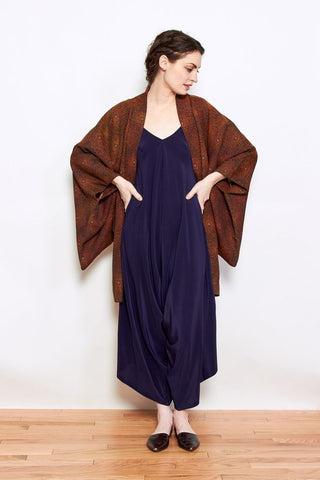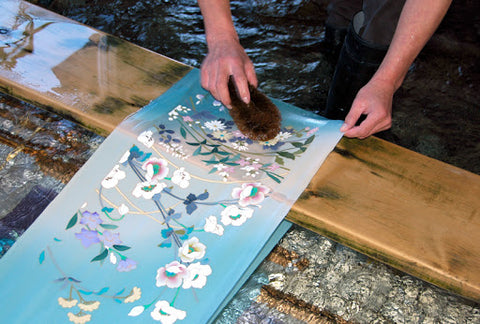Things You Probably Didn't Know About Haori Jackets
What is a Haori?
A haori (羽織) is a Japanese traditional jacket with a loose fit. They range in length from a standard jacket length, to mid-thigh, and even hong haori that can reach your calves. Unlike kimono, they don’t wrap closed, and are normally worn open, although some will have a tie that connects at the lapels.

The outer layer is traditionally made of silk, and is usually lined in silk, or sometimes cotton. The oldest vintage haori were often plain on the outside and highly decorated on the inside. This is because ostentatious displays of wealth were frowned upon and viewed as disrespectful during the Edo period. Haori jackets can be worn by men and women, though you will find some slight differences in style for the different genders.

Click here to see our Vintage Haori Jackets
Where do Haori Come From?
Haori were originally worn by warriors during the sengoku period (around the 16th century) over their battle armor to protect against the cold weather. Later they became popularised among women by geisha who would wear them over their kimono as a fashionable item. Since they had been traditionally been worn by men up until this point, they were seen as particularly stylish and for women to wear. From the 18th century, haori started to became commonplace enough that they would be decorated with family crests, and came to be seen at traditional ceremonies. This shift from an exclusively male samurai item to attire for all Japanese people means that the haori has a long legacy in Japanese culture and is a perfect piece for a classic wardrobe.
How to Wear a Haori Jacket?
As haori are loose fitting, they are very easy to wear, slipping easily over bare shoulders, layers of kimono, thick winter jumpers, or any other outfit.
When purchasing a haori, it will mostly come down to personal preference in terms of how decorated you want it to be and how you want to wear it. But whatever pattern or style you go for, haori always look striking when paired with western clothes. An ideal look to go with your haori is pairing it with jeans or plain pants and a shirt, it can also look romantic when worn over a long dress, especially if the colors in the dress match those in the haori.
It is a versatile piece that provides a coverup for chillier days as well as something that looks totally unique. You can also accessorize your haori by wearing a scarf with it which provides an elegant look, or you can fix it with a belt; although this isn’t traditional it looks good! A black belt will suit most haori and give your outfit a put-together look.

What’s the Difference Between Haori, Hanten and Happi?
There are a few traditional Japanese jackets and each one fulfills a different purpose. The hanten, for example, is thought of as a less formal and luxurious jacket than the haori and were made to suit workers who spent a long time outside. For this reason, they are perfect for wearing on colder days or in the evening as they are padded and can easily replace your standard winter jacket for something a bit more unique.

Happi are similar to Hanten but would be worn by workers who typically spent the day inside, and so they are much lighter. They normally have a simple design woven into cotton and will be dyed one color overall. These days, Happi are mostly seen at festivals, but also make for a great option to replace your spring or fall jacket. The hanten and happi are very similar in style and decoration so are generally worn interchangeably, whereas haori can cost hundreds of dollars, are highly decorative and use the highest quality fabrics.


Traditional Haori Patterns and Dyeing Methods
Like kimono, haori are made from various pieces of hand decorated fabrics and while silk and cotton are the preferred fabrics used to make vintage haori, these days synthetic fabrics are favored like polyester and rayon. Whatever the fabric, haori capture the elegance of Japanese design and culture.
Shibori - One of the primary ways of dyeing haori, this painstaking technique involves tying up parts of the fabric before it is immersed into ink to create intricate patterns between the dyed sections and raw fabric. Tiny dots and lines create beautiful images across the garment. It dates back to the eighth century and is a common method for dyeing haori.


Yuzen - Yuzen involves hand-painting elaborate and colorful patterns onto silk. The art can be traced back to the Edo period and is the primary method of dyeing kimono and creating designs on the back of haori to produce finished images of deep and vivid color.



Natural Patterns - It’s very common for haori to feature scenes from nature or one particular flower or plant such as the cherry blossom, clematis, or an all-over floral pattern. You’ll also be able to find animals such as cranes and haori featuring subtle wave patterns.

An Antidote to Fast Fashion
Kimono have always been very expensive due to the luxurious fabric and craftsmanship that goes into each piece. As a result, they are passed down through the generations until they wear out. When they can no longer be worn, the fabric is recycled to create all manner of accessories or lifestyle items. This reusing and sustainability applies equally to vintage haori jackets too, making this one of the most sustainable forms of fashion. Reusing vintage clothes is a movement, and there’s no better way to get on board than finding your own vintage haori or kimono.
Click here to see our Vintage Haori Jackets


